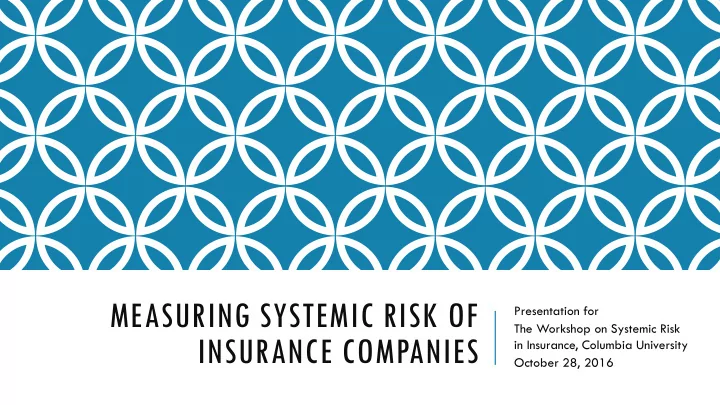

MEASURING SYSTEMIC RISK OF Presentation for The Workshop on Systemic Risk INSURANCE COMPANIES in Insurance, Columbia University October 28, 2016
IMPORTANT OBSERVATION There is a “fixed” amount of risk in the economy – no matter how the risk is sliced and diced, someone or some entity has to hold it. Because of their capital structure and key roles in financial intermediation, if banks reduce their footprint, then someone or some entity must pick up the slack.
ARE INSURANCE COMPANIES SYSTEMICALLY RISKY? Agreement that banks (and shadow banks) can create systemic risk Much more controversial for insurance companies – Metlife sued FSOC January 2015 over their decision to designate Metlife as a SIFI. The designation was struck down in March, 2016. At the U.S. appeals court this week. Whatever the decision, it may well end up at the Supreme Court. Growing body of literature - Acharya, Pedersen, Philippon and Richardson (2010), Billio, Getmansky, Lo, and Pelizzon (2011), Baluch, Mutenga and Parsons (2011), Paulson-Plestis- Rosen-Mcmenamin-Mohey-Deen (2014), Acharya and Richardson (2014), Acharya, Philippon and Richardson (15), and Cummins and Weiss (2012, 2014) versus Harrington (2009, 2014), Tyler and Horning (2009), Grace (2010), Park and Xie (2011) and Chen, Cummins, Viswanathan and Weiss (2012). Two books on the topic: Biggs & Richardson, editors (2014) and Hufeld, Koijen and Thimann, editors (2016)
BANKS VERSUS INSURANCE COMPANIES BANKS TRADITIONAL INSURANCE FIRMS Assets correlate to the economy Underwriting risks of traditional insuers ’ claims (e.g., life insurance) diversifiable Hold short-term liabilities that are more liquid than Insurance polices have high renewal rates, making their assets, making them vulnerable to runs them less vulnerable to runs
ARE MODERN INSURANCE COMPANIES OUR MOTHER’S INSURANCE COMPANY? LARGE MODERN LIFE INSURANCE COMPANIES TRADITIONAL INSURANCE FIRMS Risk exposure to the economy Underwriting risks of traditional insurers’ claims - Investment-oriented life insurance policies with (e.g., life insurance) diversifiable minimum guarantees (Acharya-Biggs-Richardson- Ryan) - Financial insurance against losses (tied to macro events) - Large investors in corporate bonds and mortgage-backed securities (Becker-Opp, Brewer-Carson-Elyasiani-Mansur-Scott, Baranoff- Sager, Stanton-Wallace) Withdrawable liabilities via variable annuities Insurance polices have high renewal rates, making (Paulson-Plestis-Rosen-Mcmenamin-Mohey-Deen) them less vulnerable to runs Shadow banking activities (funding-agreement- backed notes and commercial paper, securities lending, regulatory arbitrage (Koijen-Yogo))
DEFINING SYSTEMIC RISK Definition - Systemically risky if it has the potential under stress conditions to cause harm to the broader economy Two major negative externalities Aggregate capital shortfall Run on liabilities resulting in fire sales Insurance Companies Financial disintermediation resulting from aggregate capital shortfall (insurers finance 20% of corporate bonds, 12% of commercial mortgages) (Acharya-Almeida-Ippolito-Perez) Fire sales (Dick-Nielsen-Feldhutter-Lando, Ellul-Jotikasthira-Lunblad, Manconi-Massa-Yasuda) amplify losses and lead to credit rationing Chen, Cummins, Viswanathan and Weiss (2012), Cummins and Weiss (2014)
MODEL OF SYSTEMIC RISK Extension of Acharya, Pedersen, Philippon and Richardson (2010), which focused on aggregate capital shortfall externality, adding fire sales externality through runnable liabilities. Acharya, Philippon and Richardson (2016). Model Features Banks choose leverage and the types of assets to invest in Two Externalities The fire sale externality (arising from “runs”) is simply proportional to the amount of liquidated assets, which is endogenously determined. The going concern (aggregate capital shortfall) externality depends on the aggregate shortfall of free capital in the financial system. The social planner chooses an optimal tax to maximize the sum of the financial firms’ owner’s equity value net of the two externalities. (We assume bondholders break even.) Without the tax, the firm takes on too much leverage and asset risk (as they do not care about the externalities).
MODEL OF SYSTEMIC RISK CONTINUED… Optimal Taxation (Systemic Risk Contribution) g j x (probability of an aggregate capital shortfall) x (firm’s expected capital shortfall conditional on a crisis, i.e., when there is an aggregate capital shortfall). f x (probability of a fire sale crisis) x [ (a firm’s quantity of assets ) x (probability of insolvency conditional on a fire sales crisis) scaled by the fraction of assets that must be sold minus (the expected capital of the firm relative to required capital conditional on a fire sales crisis) This second component highlights the role of runnable liabilities, liquidity of assets, the quantity of assets, leverage capital requirement, probability of insolvency in a crisis.
EMPIRICAL OBSERVATIONS Aggregate Capital Shortfall As a % of SRISK in the financial system, insurance companies are capturing large and larger share. This is troubling if insurance companies are engaged in key financial intermediation activities. Run Risk and Default Evidence during the crisis of high CDS spreads on insurance companies (i.e., default risk) and these defaults are likely to occur when the financial system is in trouble. More evidence that, for large life insurance companies, liabilities are runnable.
EMPIRICAL OBSERVATIONS: CONTRIBUTION TO AGGREGATE CAPITAL SHORTFALL (“GOING CONCERN”) Relative systemic risk of the insurance sector
SRISK OF MOST SYSTEMIC INSURANCE COMPANIES 60000 50000 40000 HIG:US 30000 PRU:US LNC:US PFG:US 20000 MET:US 10000 0 -10000
EMPIRICAL OBSERVATIONS: CONTRIBUTION TO FIRE SALES (“CURRENT ASSETS / ACTIVITIES”) 4500 1400 Average CDS Spread for 20 Insurance CDS The Level of CRSP Value-Weighted 4000 1200 3500 Spreads of 1000 3000 Firms (in b.p) the 800 2500 Index 2000 600 insurance 1500 400 sector 1000 200 500 0 0 7/3/2006 9/3/2006 11/3/2006 1/3/2007 3/3/2007 5/3/2007 7/3/2007 9/3/2007 11/3/2007 1/3/2008 3/3/2008 5/3/2008 7/3/2008 9/3/2008 11/3/2008 Date CRSP level CDS spread
EMPIRICAL OBSERVATIONS: CASE OF METLIFE (AS OF 2014) Withdrawable liabilities $100 bn of variable annuities, $49 bn (of $308 bn of general account liabilities) with no penalty Shadow banking $52 bn funding agreements, $35 bn funding agreements backed notes and commercial paper $30 bn securities lending $400 bn of derivatives (possibly for hedging purposes) Guaranteed Investment Contracts $48 bn of GICs or separate accounts with guarantees Investment Assets Holds “over 4 days average daily trading volume” in corporates, “over 12 days” for asset -backed securities
CDS PREMIUMS OF METLIFE 1200000 1200 1000000 1000 800000 800 600000 600 SRISK CDS Premium 400000 400 200000 200 0 0 5/2/2005 5/2/2006 5/2/2007 5/2/2008 5/2/2009 5/2/2010 5/2/2011 5/2/2012 5/2/2013 5/2/2014
Recommend
More recommend